How to get rid of aphids on currants: effective ways to combat
Without guile, we can say that aphids are one of the most terrible pests in their summer cottage. Monstrously tenacious and fertile creatures affect a huge number of garden and vegetable garden crops, the most "annoying" melon aphid attacking cucumbers... She is able to settle and on roses, fruit trees (especially apple trees) and, of course, on berry bushes, which, unfortunately, also do not pass by.
To combat this small but very nasty pest, you need to constantly apply a number of measures aimed at preventing and protecting currants, as well as gooseberries. Moreover, it can be both folk remedies and chemical preparations against pests (insecticides).
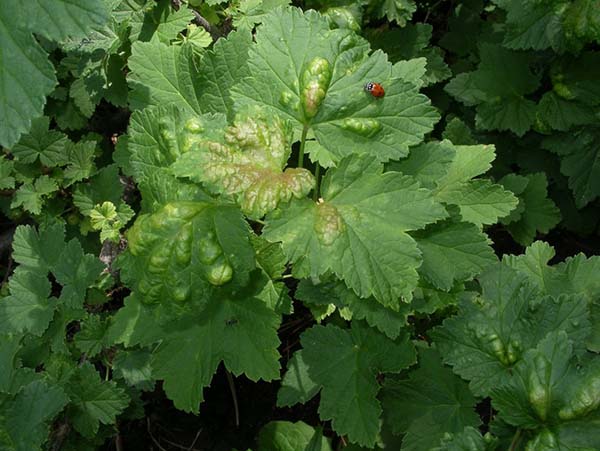
Content
What aphid attacks the currant: types and signs of bush damage
Usually, aphid peak falls on May June, although during the summer the pest does not sleep, actively multiplying and populating the entire garden with its offspring.
Aphid life cycle next: in early spring, when the temperature rises, insects appear from the laid eggs, which begin to multiply rapidly, feeding on plant juices. Malicious pests (wingless form) suck them (juices) with the help of their proboscis, piercing the youngest and most tender leaves, shoots and buds. When there are too many aphids, and the plant dries up, a generation of winged forms is born, individuals of which scatter to neighboring bushes. In autumn, eggs are laid in favored places.
Usually damage such as swollen, twisted, and then reddened leaves currants and gooseberries with clusters of larvae on the inside of young leaves, testify about what's on your site a small and dangerous pest has settled - aphids.
Most often, currants are affected two varieties of aphids, each of which prefers its own berry color: gallic - red and white, and gooseberry - black.
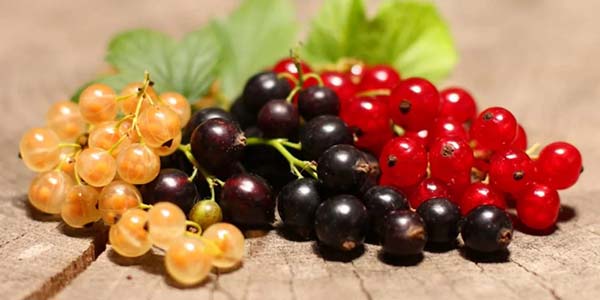
By the way! Aphids and ants are good friends (faithful companions), since the latter love to feed on the carbohydrate secretions (molasses) of our small pests, transferring them from one place to another. So the fight against aphids is and fighting ants.
Gall aphid (leaf)
If on red or white currants characteristic red, blistering spots (these bubbles do not immediately acquire color), this means that a gall aphid attacked your berry bush (Capitophorus ribis).
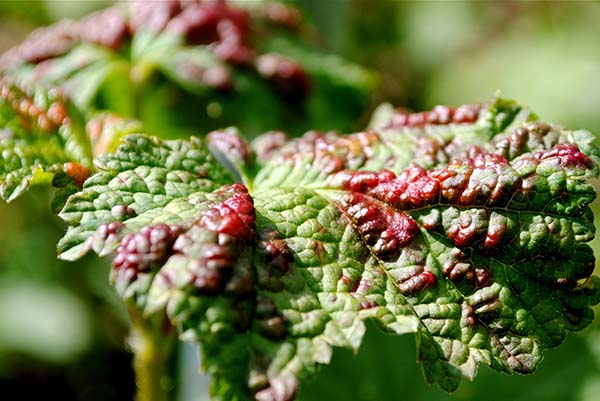
She usually hides exactly on the back of the leaves and it is very difficult to see it, as it is even smaller than melon that attacks cucumbers (less than 2 mm).
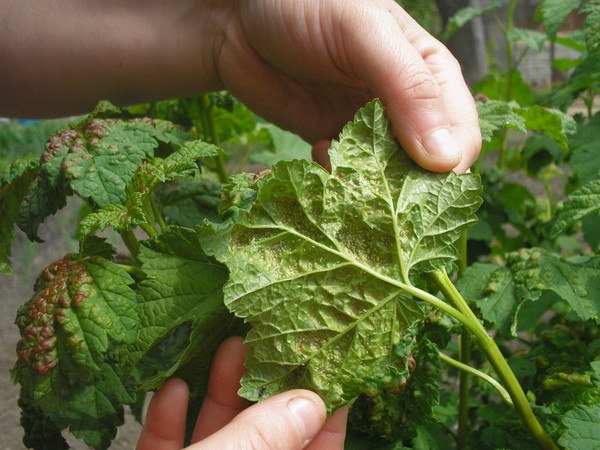
If you do not find and take appropriate measures in time, it will start gradual death of leaves... Then, naturally, significantly yield will fall, and the bush itself will slowly begin to die.
Gooseberry aphid (shoot)
Discover what's on your black currantgooseberry aphid attacked (Aphis grossulariae),you can by twisted leaves on the tops of the shoots (like a cocoon).
By the way! Leaves twisted into cocoons are very convenient for aphids for their own protection, because predatory insects cannot see it this way.
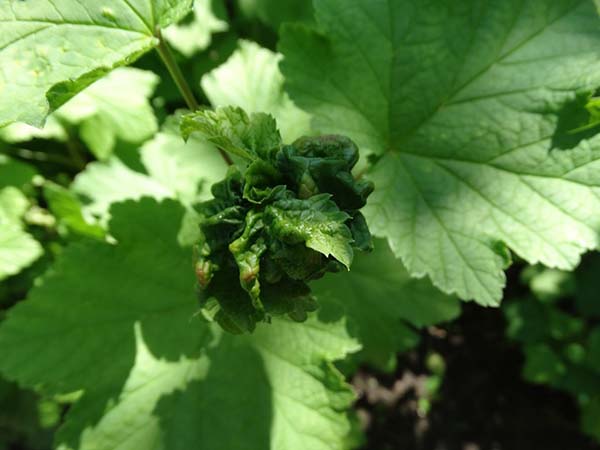
If you unfold these leaves, you will see a huge number of aphids and their eternal companions, or rather, defenders and carriers - ants.
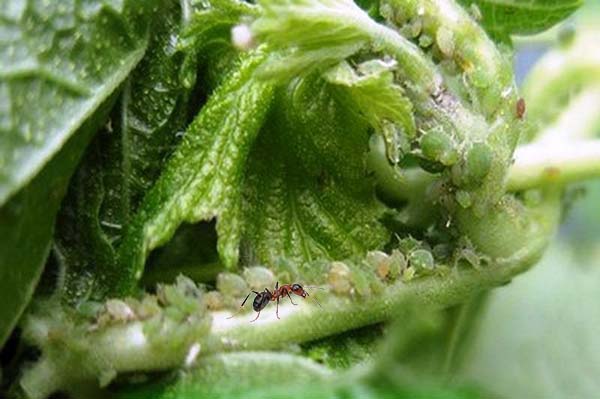
Because of this fruit bush start to shrink, they have taste disappearsand they might even start fall spontaneously.
Video: aphids on currants - where does it come from and how to deal with it
Methods of dealing with aphids on currants: folk, chemical and biological means
You can defeat aphids on currants in a fairly short time if you spray berry bushes in early spring with certain insecticidal preparations.
But if you know that your shrubs are usually not very much affected, then you can use less aggressive folk remedies for fighting aphids, especially with small infestations.
The easiest way is to wash off the aphids with a sharp stream of water from a hose from the back of the leaves (90% of the aphids fall and die).
Important! The main thing is not to miss the moment and spray the currants before flowering or immediately after the first ovaries are formed.
Processing can be carried out in the fall, after the harvest.
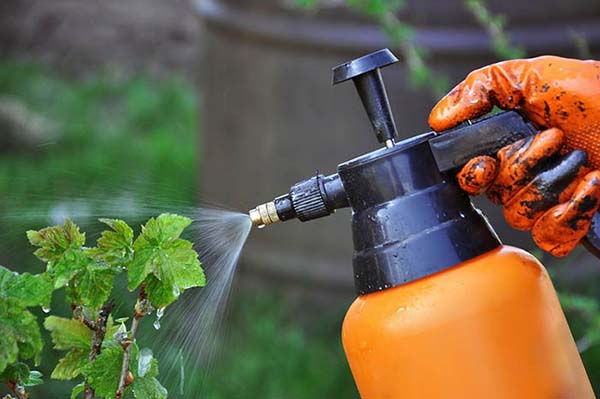
Rules for processing currant bushes from aphids:
- Itself sprayingusually do upwardsso that the lower surface of the sheet is better processed.
- As for the time of day, the processing of currants from aphids should be carried out in the early morning or late evening, naturally, not in rainy weather.
- When treating white or red currant leaves for gallic aphids, do not forget to turn the leaves, and from gooseberry aphids, unfold them to spray directly on the pest. This is why it is more convenient to use a hand sprayer rather than a standard large sprayer.
Note! The means of fighting against gallic and gooseberry aphids are absolutely the same, that is, they will help get rid of any of its varieties.
Video: spraying currants from aphids
Chemicals
If the currant suffers from a severe infection of the misfortune, then only chemical agents (insecticides) will help you to combat aphids.
The most popular chemical preparations against aphids are (the active ingredient, the method of entry, and the chemical class of the agent are indicated in brackets):
- Actellic (Pirimifos-methyl (Actellik), a systemic enteric insecticide + fumigant, organophosphorus compounds (FOS) class;
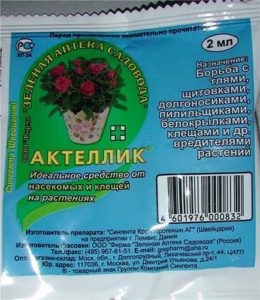
- Aktara (Thiamethoxam (Aktara), a systemic intestinal insecticide, neonicotinoid class);
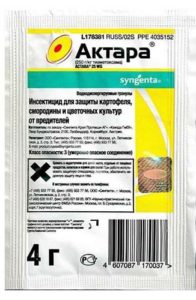
- Aliot (Malathion (Karbofos), an intestinal-contact insecticide, organophosphorus compounds (FOS) class;
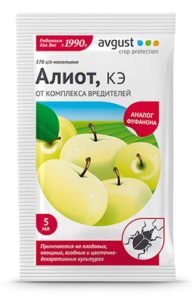
- Biotlin (Imidacloprid, systemic insecticide of intestinal action, class of neonicotinoids);
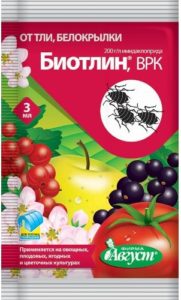
- Tanrek (Imidacloprid, systemic insecticide of intestinal action, class of neonicotinoids);
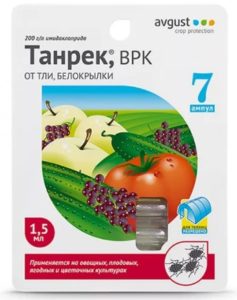
- Spark - Double effect (Permethrin and Cypermethrin, an intestinal-contact insecticide, pyrethroid class);
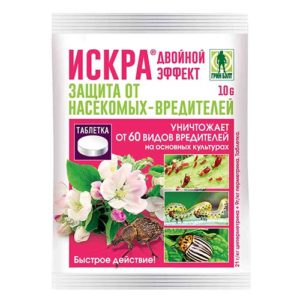
- Spark Gold (Imidacloprid, systemic insecticide of intestinal action, class of neonicotinoids);
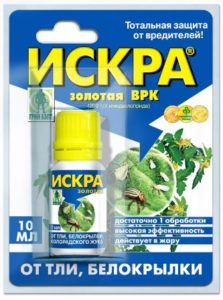
- Inta-Vir (Cypermethrin, insecticide of intestinal action, pyrethroid class);
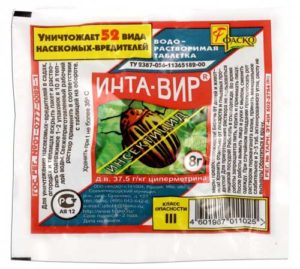
- Kinmix (Beta-cypermethrin, an intestinal-contact insecticide, pyrethroid class);
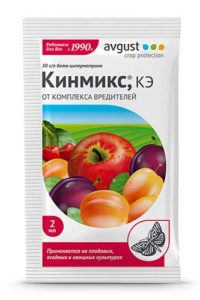
- Fufanon (Karbofos (Malathion (Karbofos)), an enteric-contact insecticide, organophosphorus compounds (FOS) class;
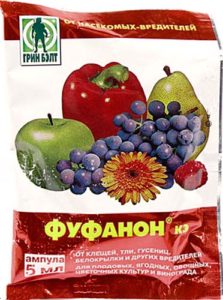
- Karbofos (Malathion (Karbofos), an intestinal-contact insecticide, organophosphorus compounds (FOS) class.
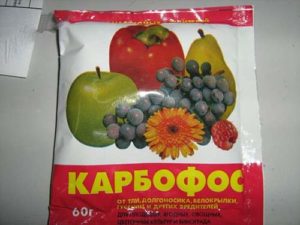
By the way! From wintering stages of pests the drug has proven itself well 30 Plus (Vaseline oil, contact action, mineral oil class) and Prophylactin (Vaseline oil and Malathion (Karbofos), intestinal action, class mineral oils + organophosphorus compounds (FOS).
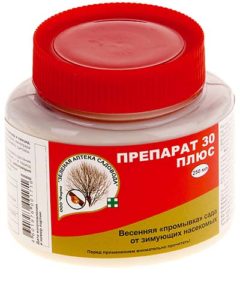
The first spraying with an insecticide is recommended in early spring, before the buds bloom.
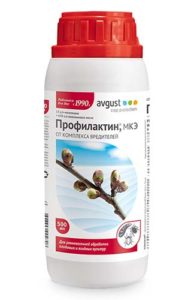
Note! Aphids are one of those pests that are almost impossible to defeat completely, they will constantly infect your berry bushes.
Therefore, some gardeners believe that if you often use chemicals, it is unlikely that this will have a good effect on your plants and the usefulness of their fruits.
However, it should be borne in mind that at the end of the waiting period, the drug completely dissolves and evaporates, in other words, chemical agents do not accumulate in plants.
Biological preparations
It is much more environmentally friendly to use special biological agents against aphids on currants.
As a rule, biological products are based on bacterial strains, but there are also those made on toxic secretions of a soil fungus - Aversectin C (for example, Fitoverm, Aktofit - these are all analogues).
Among the most common biological agents for aphids on berry bushes, the following are distinguished (the active ingredient, the method of penetration, and also the chemical class of the agent are indicated in parentheses):
- Aktofit (Aversectin C, enteric contact insecticide, class Avermectins + biological pesticides);
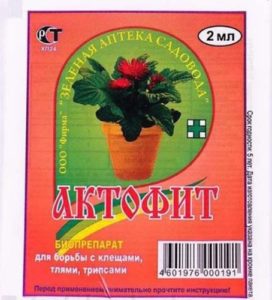
- Fitoverm (Aversectin C, enteric contact insecticide, class Avermectins + biological pesticides);
Aktofit and Fitoverm are analog drugs that have the same active ingredient.
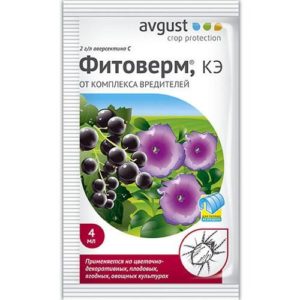
- Bitoxibacillin (Bacillus thuringiensis var. Thuringiensis, intestinal pesticide, bacterial insecticide + biological pesticide class);
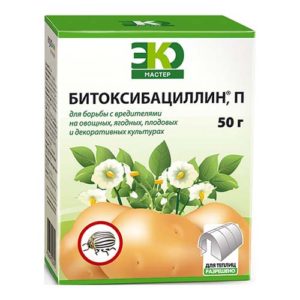
- Spark BIO (Avertin N, enteric insecticide, class Avermectins + biological pesticides);
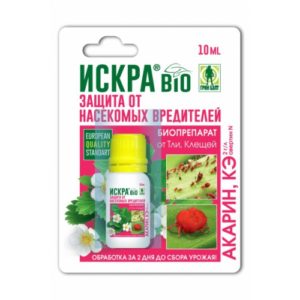
- Akarin (Avertin N, enteric contact insecticide, class Avermectins + biological pesticides);
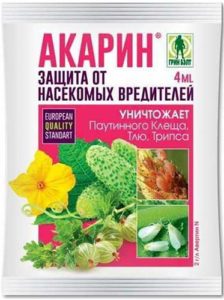
Iskra BIO and Akarin are analogues.
- Tobacco dust (Nicotine, intestinal action, class plant insecticides).
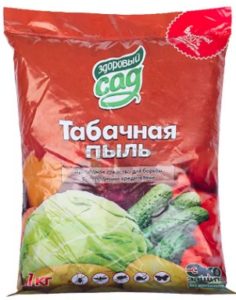
Important! The main advantages of using biological and folk remedies in the fight against aphids is that in just 1-2 days (be sure to read the instructions) after processing, you can eat currant berries.
Many of these drugs also help in the fight against Colorado potato beetle, weevils and whitefly, including on other plants.
Tearing off and destroying diseased leaves
If, in early spring, you notice twisted, swollen and reddened currant leaves affected by aphids (when its number is still minimal), then simply cut them all off or cut them off and then burn them.
Important! This is even useful, since currant shoots (but black currant) are activated and grow, if, of course, you spend spring formative pruning according to all the rules.
The same goes for pruning gooseberries in the spring.
Video: aphids on currants, what to do - tear off the infected leaves
By the way! Pouring boiling water over currants in early spring also carried out as an aphid treatment.
Folk remedies: ammonia, soda
A fairly safe and effective means of dealing with aphids on currants is ammonia (ammonia solution).
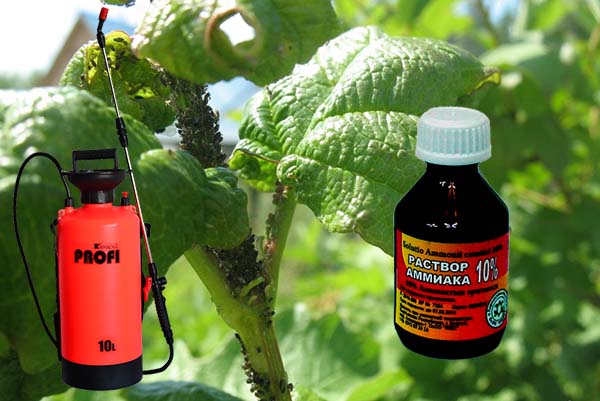
Important! Such processing can be carried out, including when fruits are already forming on the currants (that is, in June). Moreover, you can safely use the leaves to make tea.
To prepare a spray solution, you will need:
- any detergent (it is best to make a soap solution from laundry soap, although you can take the most common liquid soap or use some kind of dishwashing detergent) for better adhesion. About 30-40 grams or 2 tbsp. spoons of liquid.
- 10 liters of warm clean water (initially everything can be dissolved in 1 liter);
- 10% ammonia (ammonia) - 2 tbsp. spoons (or 30-40 ml).
Next, you just have to pour the solution into the sprayer and process the currants from aphids.
By the way! In general, ammonia is also a relatively effective nitrogen fertilizer.
Video: ammonia from aphids on currants
Soda
To prepare a working solution, you will need to take about 10 tbsp. spoons baking soda and dissolve in 1 bucket of water. To keep the product on the leaves better, also add a little grated laundry soap (30-40 grams per 10 liters).
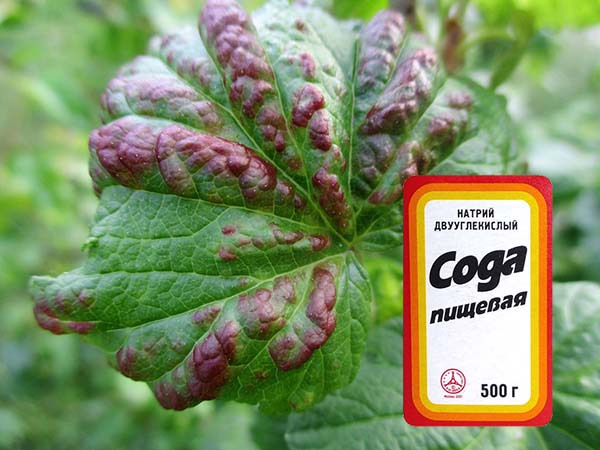
But, according to gardeners, a much more effective remedy against aphids on currant leaves is spraying them soda ash with the addition of iodine (will help against powdery mildew).
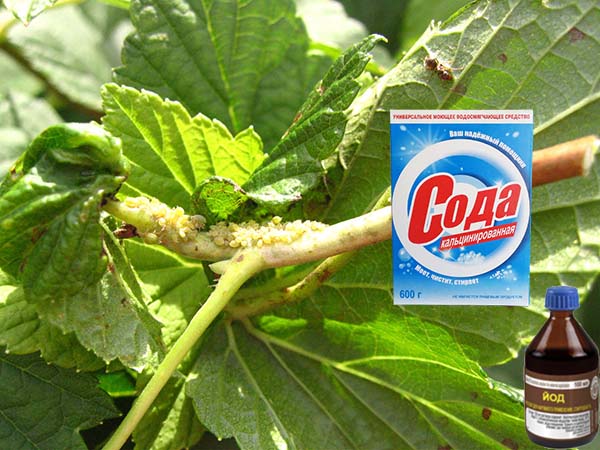
The recipe is as follows: 2 tbsp. l. soda ash, 1 tsp. iodine per 10 liters of water, as well as 40 grams of household or tar (even better) soap, if liquid, then 2 tbsp. spoons.
Video: super aphid remedy - soda ash and iodine
Herbal infusions and decoctions
Important recommendation! Berry bushes should be treated with herbal infusions before flowering or after harvest. In other words, you need to spray them when the aphids are not yet there, then it simply will not sit on this plant. To get rid of aphids on currants during the period of its activation in this way is hardly possible.
The following plants are suitable as folk remedies for controlling aphids using herbal infusions (in the calculation of approximately 300-400 grams per 10 liters of warm water):
- tomato tops (infusion time - 5 hours);
- potato tops (1 kg, let it brew for 3 hours);
- onions (namely, chopped heads, 5 hours);
- garlic (chopped heads, 4-5 days);
- dry tobacco leaves (2 days);
- chamomile (dry grass and inflorescences, 12 hours);
- dandelions (leaves and roots, 3 hours);
- marigolds (fill a bucket with green mass together with inflorescences, let it brew for 2 days);
- horse sorrel (roots, infusion time - 3 hours);
- pine (1 kg of needles, leave for 7 days);
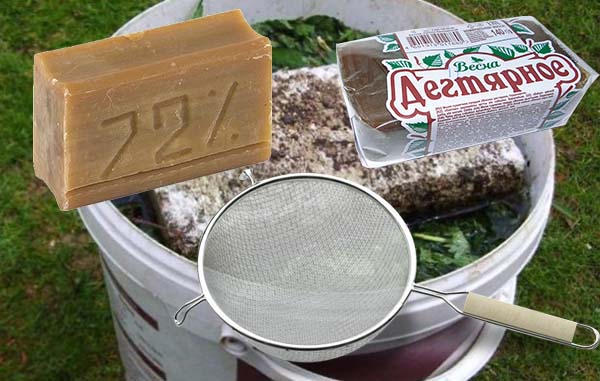
Important! Do not forget to add 40 grams of soap (household or tar) per 10 liters to each of the solutions before using it and strain it first.
Strange and original remedies
Some very creative summer residents came up with the following means for spraying currants from aphids:
- vodka;
- Coca Cola;
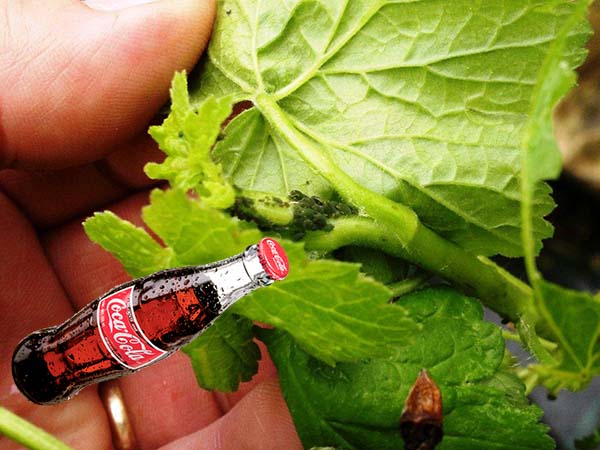
- cream and essential oil (200 grams of cream, 40-60 drops of tea tree or lavender and 10 liters of water, spend 3 sprays in 3 days);
- sunflower oil (200 ml per 10 liters of water);
- milk and iodine (1 liter of milk and 5 ml of iodine per 10 liter of water).
Plant repellents
To scare off aphids, you can put or tie a blooming twig right on a currant or gooseberry elderberry, although it is better to put it in a jar of water so that the plant does not wither quickly. Similarly, you can use tomato tops, chopped garlic or onions.
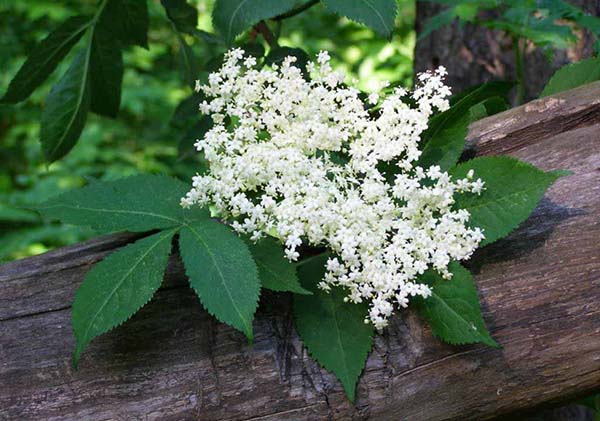
And you can plant various next to the bushes strong-smelling plants (greenery, flowers), eg:
- marigold;
- lavender;
- tansy;
- sagebrush;
- yarrow;
- calendula (marigold);
- thyme;
- onion;
- garlic;
- white mustard;
- dill;
- parsley;
- basil;
- mint;
- coriander.
However, it should be understood that with a strong infection of currants, such remedies are unlikely to be effective against aphids.
Biological enemies
The main natural enemy of aphids is ladybug, as well as the lacewing, wasp and ground beetle.
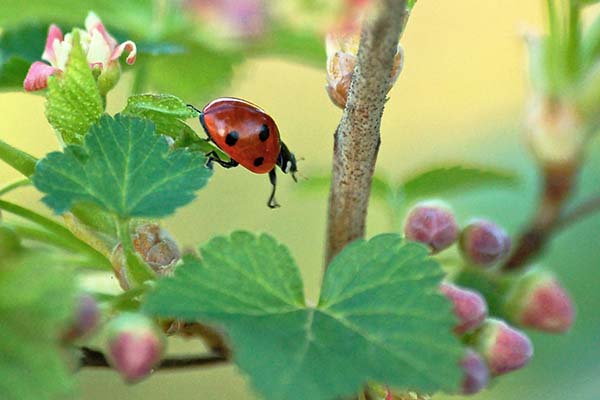
Important! If there are ants on the currants (the main defenders and carriers of this infection), then no ladybugs will help you, since they will quickly drive them off the bushes.
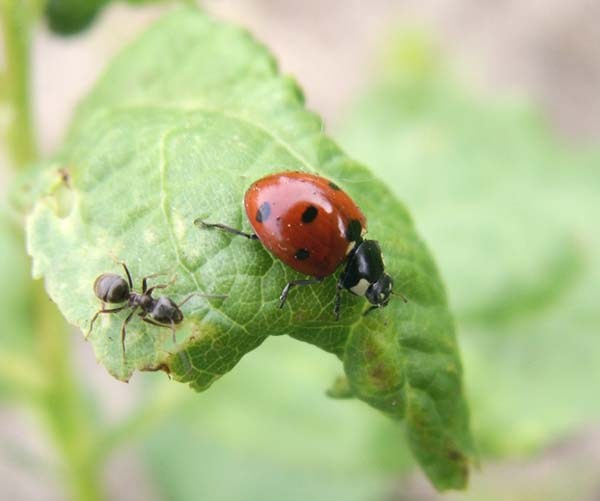
These beneficial insects can be attracted by the same fragrant (smelling) and nectar-bearing plants and herbs, which should be planted near currants and gooseberries:
- buckwheat.
Birds
Aphids are quite a desirable object of prey for many small birds, with which they love to feed their chicks.
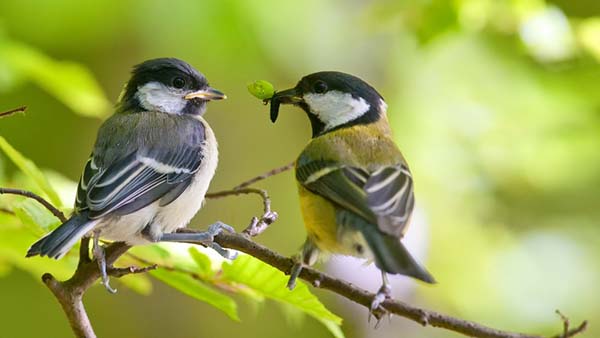
These beneficial birds include:
- sparrows (who also like to nibble on cherries);
- tits;
- less known and less common: beetles, wrens, robins, robins, linnet, chiffchaff and willow warblers.
To make these birds fly to your site, simply equip it with birdhouses and feeders. However, no matter how later you have to construct garden scarecrows, on the contrary, to scare them away.
By the way! If you want to drive away aphids and not harm beneficial insects and birds, then it is better to choose more gentle (not chemical!) Methods of processing currants.
Fighting aphids is never easy. But if you want to get a good result and for a long time, then "extinguish" the pests not only by the power of the poison, but regularity ongoing activities.
Video: protecting currants and gooseberries from aphids


Thanks a lot for the very helpful article.